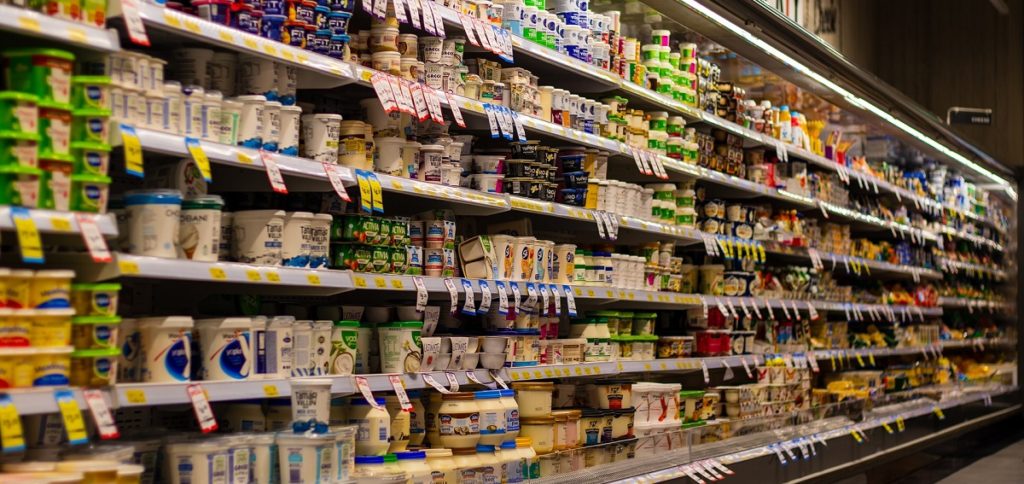Competitive advantages thanks to innovative packaging technologies

Automated production with the use of robots is mainly associated with the automotive industry. Today, such modern technologies are emerging in a growing number of industries, including the food and consumer goods industry. In 2018, the food sector had one of the strongest year over year growth rates with around 32 percent of all newly installed robots. Danone, from the dairy industry, is an example showing how modern robotics is being successfully used to innovate top cup packaging for yogurt.
Yogurt with “just” fruit hardly sends consumers down the yogurt aisle these days. The market for fruit yogurt in Germany has been in decline for years. From 2011 to 2018, the per capita consumption of fermented dairy products declined by one kilogram to 29.9 kg per year, reports the ZMB (Central Market and Price Reporting Authority in Berlin) in its 2019 Yearbook for Milk. This also corresponds to a decline in the raw materials that comprise yogurt, which fell by 9.2 percent to just over one million tons in the period noted. This decrease in the sales volume of around 100 million kilograms of milk corresponds to the annual processing volume of a small-scale dairy – which highlights the direct impact on the dairy industry.
Innovative packaging technology with the top cup

It’s no surprise that yogurt manufacturers are doing everything possible to maintain or increase their market share through product innovations. These product updates are often successful because of creative modifications or new packaging inventions. For example, the top cup. It is an extended snap-on lid that is placed on top of the yogurt cup. It is sealed, usually transparent and involves a separate plastic packaging. It can contain cereal, chocolate balls, Smarties or other colorful and usually sweet creations which the consumer empties and stirs into the yogurt cup before consuming. Most dairies get these top cups from specialized suppliers that produce the add-ons in large quantities with efficient costs.
Application in record speed
Applying the top cup can present technical difficulties. Manual placement is usually reserved for small dairies, who operate with a hand-crafted philosophy. Special applicators are required for large-scale placement of top cups. This requires extreme precision, and speed also plays an increasingly important role. The Swiss company Stäubli created, for Danone, such a solution for innovative packaging. An “ultra quick” Stäubli FAST Picker machine applies a small, prefabricated cup with the desired topping and a plastic spoon to the top of the yogurt cup. What makes the FAST Picker so unique is its four-axis kinematic design that achieves unprecedented speeds of 237 pick-and-place cycles per minute and thereby sets a new record. It does so while operating with a food-grade NSF H1 category lubricant. The FAST Picker is quick enough to replace two Delta robots.
This innovative packaging technology gives Danone multiple advantages. With just one robot required for the cell design, the required space is substantially less. In addition, the technology results in increased efficiency by significantly raising production, reducing unit costs and achieving a new quality of packaging. Because of this, the French group has gained an edge over its competitors by using state-of-the-art robotics technology for its packaging.
New technologies include packaging materials, not just packaging types. To that end, scientists are working on new and biologically degradable packaging materials made from natural substances. These include casein, a milk protein, mushrooms and thistles, and even crab shells that can be used for environmentally friendly packaging material.
Variety boxed into a corner
It has been many years since the invention of the dual-chamber cup by Molkerei Müller. An innovative concept at the time, the packaging design gives consumers a virtually unlimited number of product varieties that cater to individual interests and meet the desire for variety. This is a small advantage for manufacturers. They make one basic recipe of yogurt which is then divided into large batches and filled into the larger packaging chamber. The added fruit mixture, placed the smaller chamber, provides the variety. The dual-chamber cup, also called the “Corner Yogurt” concept, has become the standard for many foreign and domestic yogurt manufacturers and is now viewed by consumers as less exciting.
Those hoping to gain an overview of the current status of packaging technologies in the beverage and food sector will discover all the latest information at drinktec, from October 4 through 8, 2021, at Messe München. Are you still looking for a platform to present your innovations in the field? Then join us at the next drinktec from September 13 through 17, 2021.
